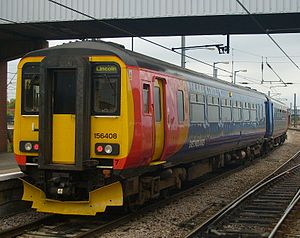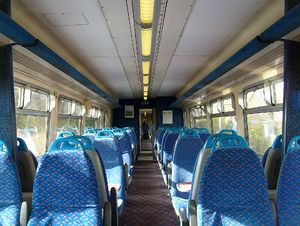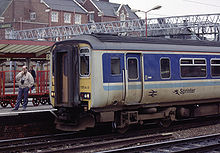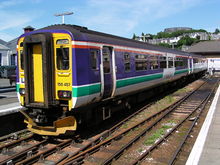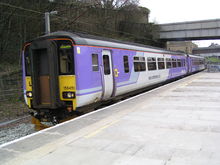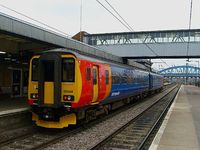- British Rail Class 156
-
British Rail Class 156 Super Sprinter
East Midlands Trains 156408 at Peterborough
Interior of National Express East Anglia 156409In service 1987 - Current Manufacturer Metro-Cammell Family name Sprinter Constructed 1987 – 1989 Number built 114 trainsets Formation 2 cars per trainset Fleet numbers 156401 - 156514 Operator Current:
East Midlands Trains
First ScotRail
National Express East Anglia
Northern Rail
Previous:
British Rail
Central TrainsSpecifications Car body construction Steel Car length 23.03 m (75.6 ft) Width 2.73 m (9.0 ft) Height 3.805 m (12.48 ft) Maximum speed 75 mph (121 km/h) Weight DMS: 35.5 t (34.9 long tons)
DMSL: 36.1 t (35.5 long tons)Engine(s) 213 kW (286 hp)
Cummins NT855-R5 Diesel
(1 per car)Transmission Voith Hydraulic T211r
(2 axles driven per car)Safety system(s) AWS, TPWS Coupling system BSI[1] Gauge 1,435 mm (4 ft 8 1⁄2 in) Standard gauge The British Rail Class 156 Super Sprinter is a diesel multiple-unit train (DMU). 114 of these units were built from 1987 to 1989 by Metro-Cammell (now owned by Alstom) at its Washwood Heath Works in Birmingham. They were built to replace elderly First Generation "Heritage" DMUs and locomotive-hauled passenger trains.
Contents
Description
The design of the Class 156 was more conservative than Metro Cammell's earlier Class 151 design. The bodyshell was made of steel instead of aluminium, and the cab design was deliberately similar to the BREL Class 150 to ease union acceptance.[2]
The units were all built as two-car sets, numbered 156401-514. Each unit was formed of two driving motors, one of which contained a toilet.[3] Individual carriages numbered as follows:
- 52401-52514 - Driving Motor Standard Lavatory (DMSL)
- 57401-57514 - Driving Motor Standard (DMS), containing an area for storing wheelchairs, bicycles, bulky luggage etc.
The vehicles are powered by 6-cylinder Cummins NT855-R5 diesel engines through Voith T211r hydraulic automatic transmissions and Gmeinder final drive units.[3] They have a top speed of 75 mph (121 km/h), although in practice speeds of up to 90 mph (140 km/h) have been observed on level track,[citation needed] though not in regular service.
Unlike the Class 150 units, the 156s have a single-leaf sliding door at either end of each coach. This reflected the expected longer journeys with fewer stops that the Class 156 was supposed to operate. As with the Class 150, only the doors closest to the cabs have passenger door control panels and they require to be armed from within the cab itself, so that the guard can operate the door controls only from a vacant cab. Units operated by First Scotrail have been fitted with door-control panels in the centre sets of doors for ease of the guard.
The first 100 units were all ordered by the Provincial Sector of British Rail, and carried the sector's livery of blue and beige with light blue stripe. Twenty units, numbers 156401-419/422 based at Tyseley depot, were later repainted into Regional Railways Express livery after the rebranding of Provincial.
The last fourteen units, numbers 156501-514, were ordered by Strathclyde PTE, and carried a distinctive orange black livery. This was later replaced by a carmine and cream livery, reminiscent of the 1950s livery carried by Mk.1 coaching stock.
Operations
British Rail
In the early 1990s, British Rail was looking to save costs on rural routes, and decided that operating two-car trains was too expensive. The company planned to convert a number of Class 156 units into single-car vehicles as Class 152. In the event, the decision was taken to do this with the Class 155 units instead.[4]
Operations outside the United Kingdom
In the summer of 1989, in connection with celebrations marking the 150th anniversary of Nederlandse Spoorwegen (NS, the Dutch Railways), British Rail was invited to send a selection of its most modern rolling stock to be exhibited at Utrecht for two weeks in the summer. Class 156 unit number 156502 from Glasgow was finally selected; it was unusual as it carried Strathclyde Passenger Executive (SPE) orange and black livery. On 16 June 1989, the unit was driven under its own power from the Railway Technical Centre by a Derby train crew all the way to the Netherlands. As the Channel Tunnel was still under construction, the SNCF train ferry was utilised to cross from Dover Western Docks to Dunkirk, from where the unit was driven through France and Belgium to the Dutch border at Essen and on to Utrecht with help from SNCF, SNCB and NS train crews. The unit was exhibited along with various items of rolling stock from across Europe for around two weeks, after which it returned to the UK.
Post privatisation
After the privatisation of British Rail, the Class 156 fleet was split between several franchises, which are described below.
Scotland
Their initial introduction was controversial as they replaced locomotive hauled stock (particularly Class 37 hauled) on longer routes. Various issues such as limited toilet facilities were cited as criticisms,[citation needed] but they proved to have much lower operating costs. It is reported they are the worst fleet in Scotland getting wheel lathe duties as a result of flats.[citation needed]
At privatisation the Scottish fleet passed to the National Express-owned ScotRail franchise, which used them until 2004 when the franchise was won by FirstGroup. First ScotRail, as the franchise currently trades, operates the largest fleet of Class 156 units. They operate on both short distance commuter routes and services of up to five and a half hours, such as Glasgow to Fort William and Mallaig.[5]
They currently operate on many core routes including:
- Glasgow South Western Line - Glasgow to Stranraer / Carlisle via Kilmarnock
- West Highland Line - Glasgow to Oban and Fort William / Mallaig
- Shotts Line - Glasgow Central to Edinburgh Waverley via Cambuslang, Bellshill and Shotts.
Units nos. 156500-514, which are operated by Strathclyde Partnership for Transport and are currently painted in Scotrail's new Saltire livery are used on Glasgow local services (in reality any of the 48 First ScotRail units can be used regardless of livery):
- Glasgow to Paisley Canal
- Glasgow to Whifflet
- Glasgow to Anniesland via Maryhill
- Glasgow to East Kilbride
- Motherwell to Cumbernauld
Additionally, these units in particular are often seen working through to Newcastle on three services per day from Glasgow Central as these services are jointly operated by First ScotRail and Northern Rail.
Generally, both local and long distance workings are interchangeable; however, only Radio Electronic Token Block (RETB) fitted units can operate the West Highland Line.
Class 156s also operate trains from Glasgow Queen Street to Stirling, Dunblane, Cumbernauld and Falkirk,[when?] as well as Edinburgh Waverley to West Calder, Perth, Kirkcaldy and Fife Circle.
In September 2008 the Scottish Government's agency Transport Scotland announced that all ScotRail trains (including those of Strathclyde Partnership for Transport) would be repainted in a new livery of blue with white Saltire markings on the carriage ends. 156433 was the first 156 to be repainted in this livery and departed RailCare Springburn on 11 February 2009.[6] All SPT units are now in Saltire Livery. All Scotrail Barbie livered trains are being left for the time being.[7]
East Anglia
In early 2005, one started to receive several former Central Trains Class 156 units, which were exchanged for Class 150 units. The newer Class 156 units are more suitable for several of the longer-distance routes, and also provide extra passenger accommodation and complement Class 153 units.
The units are used on the following local services:
- Bittern Line - Norwich to Sheringham via Cromer
- Wherry Lines - Norwich to Great Yarmouth/Lowestoft
- East Suffolk Line - Ipswich to Lowestoft/Felixstowe
- Sudbury Branch Line - Marks Tey to Sudbury
as well as the longer distance Norwich to Cambridge and Ipswich to Cambridge/Peterborough services.
National Express East Anglia currently have a fleet of nine 156s.
On 21 October 1993, 156405 became the first Sprinter to pass 1 million miles, whilst working the 10:10 Great Yarmouth to Norwich service.[8]
On 17 August 2010, 156417 was involved in a collision with a slurry tanker at a user-operated level crossing. 21 people were injured, one of them seriously.[9]
Northern England
Class 156 No. 156451 at Lancaster on 1 April 2005. This unit carries the first version of Northern Rail livery.
Following privatisation both First North Western and Arriva Trains Northern (the successor to Northern Spirit) operated Class 156s on their respective routes. The majority of these workings were inherited by Northern Rail along with their 156s at the change of franchise. The vehicles inherited from the different companies have different interiors.
Six former Arriva Trains Northern Class 156 units were transferred from Yorkshire to the North West by Merseyrail, to replace some overcrowded Class 142 Pacer units in the Merseyside area, after more than 20 extra Class 158s were introduced in Yorkshire. The franchise's units, split between depots at Heaton (Newcastle) and Newton Heath (Manchester), operate as 'common user' on a day-to-day basis, and are liable to appear working well away from their supposed home depot's routes (the opposite of what used to happen under British Rail, when units rarely strayed from their home depot's locality). Within the Northern region, Class 156s are concentrated in the north-west and also the north-east especially between Middlesbrough & Whitby where fourteen 156 units are being fitted with GPS as a trial for Northern Rail, but are uncommon now in Yorkshire / Humberside, where Class 158s and others are used instead.
Northern Rail has so far introduced three new liveries. The first, carried by 156451, is mainly mauve, but with white bands. The second livery, as carried by 156425/460/464 is the inverse of the first livery. The final livery, first applied to 156461, is similar to the second livery, but with the white replaced by blue.
Midlands
A Central Trains Class 156 DMU at Coventry in 2000. It is still in the old BR livery, but has a Central Trains name tag.
In 1997, newly-privatised Central Trains inherited twenty units from Regional Railways[10] for use mainly on long-distance trains such as:
- Birmingham to Nottingham via Derby or Leicester
- Birmingham to Hereford
- Birmingham to Shrewsbury and the Cambrian Line
- Nottingham to Skegness or Lincoln.
In an attempt at fleet standardisation, preparations were made during 2003 to exchange the entire Class 156 fleet for an equal number of ScotRail Class 158s.[11] and unit 156402 was partially repainted in ScotRail colours in readiness. The transfer was ultimately cancelled, however, and reliverying of the bulk of the fleet into Central Trains' own green-and-yellow livery took place between 2003 and 2005.[12] A total of nine units were later transferred away to 'one' Railway during early 2005, in exchange for Class 150 units.
At the end of the Central Trains franchise, the remaining eleven units were transferred to East Midlands Trains, who went on to repaint the fleet during 2008[13] and then carry out a £5m refurbishment programme from autumn 2010 onwards.[14] The refurbishment, carried out at Neville Hill depot in Leeds, includes interior refurbishment work, improvements to driving cabs and installation of CCTV.[15] These trains are now used on slower medium-distance services such as Nottingham/Derby to Matlock, Nottingham to Skegness, Leicester to Lincoln and Nottingham to Worksop. From May 2011, four additional units currently in use by Northern Rail will be added to East Midlands Trains' fleet.[15]
Models
- Hornby produces a version of the 156 in OO although it does not have bidirectional lights
- Oovee Entertainment produces a Class 156 for the computer game Railworks 2 (from 15 April)
- Dapol make a N model with bidirectional lights
References
- ^ "Mechanical And Electrical Coupling Index". Rail Safety and Standards Board. http://www.rssb.co.uk/RGS/Pages/MECHANICALANDELECTRICALCOUPLINGINDEX.aspx. Retrieved 2010-12-20.
- ^ dysgraphyk. "Class Origins". http://members.madasafish.com/~dysgraphyk/156/class156_origins.htm. Retrieved 2010-03-11.
- ^ a b The Railway Data File. Leicester: Blitz. 1999. p. 82. ISBN 9781856054997.
- ^ All Time Guide to Traction Classification - Part 3: Diesel Multiple Units - The Railway Centre
- ^ scot-rail.co.uk >> Class 156
- ^ transport scotland.co.uk - livery
- ^ scot-rail.co.uk >> Class 156 Relivery
- ^ The British Rail Years - 156 Super-Sprinter - 156 Super Sprinter DMU. Retrieved 2010-09-11
- ^ Adam Gabbatt and James Meikle (18 August 2010). "Suffolk rail crossing crash leaves man with life-threatening injuries". The Guardian (London). http://www.guardian.co.uk/world/2010/aug/18/suffolk-rail-crossing-crash. Retrieved 2010-08-18.
- ^ Knight, Steven, ed (1997). A comprehensive guide to Britain's new railway. Peterborough: EMAP.
- ^ http://dysgraphyk.madasafish.com/156/class156_liv-wp.htm
- ^ http://dysgraphyk.madasafish.com/156/class156_liv-ct.htm
- ^ "East Midlands Trains launches first re-branded Class 156 train" (Press release). East Midlands Trains. 4 April 2008. http://www.eastmidlandstrains.co.uk/EMTrains/AboutUs/News/_EastMidlandsTrainslaunchesfirstre-brandedClass156train_.htm.
- ^ "Rail passengers welcome first trains to undergo part of £5m makeover". Lincolnshire Echo (Lincoln). 29 September 2010. http://www.thisislincolnshire.co.uk/news/Trains-revamp-just-ticket-passengers/article-2696889-detail/article.html.
- ^ a b Miles, Tony (December 2010). "EMT refurbished Class 156 launched". Modern Railways (London): p. 88.
External links
- Metro-Cammell class 156 Super-Sprinter - Information about current and past Class 156 operation, including technical details, liveries and accident reports.
- The story in pictures of 156502's visit to Holland
- British Photo Database - Class 156 Super-Sprinter
20 m: 23 m (Super Sprinter): unbuilt: Diesel multiple units of the United Kingdom First generation units: First Generation
Original TOPS:First generation units
(pre-TOPS):British United Traction · Derby Lightweight · Metro-Cammell · Railbus · GWR Railcars · LMS Railcars
Second generation units: Diesel-electric units: Southern Railway designations: Families Categories:- British Rail diesel multiple units
- Metropolitan Cammell multiple units
Wikimedia Foundation. 2010.

